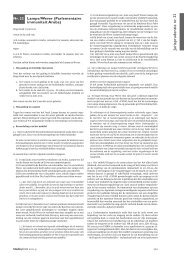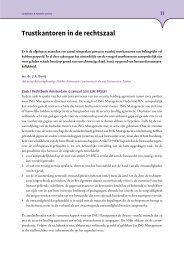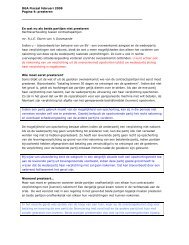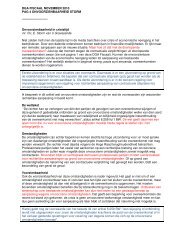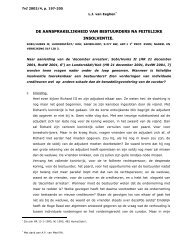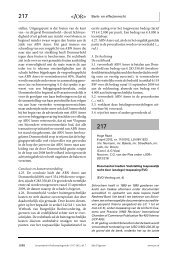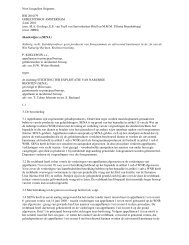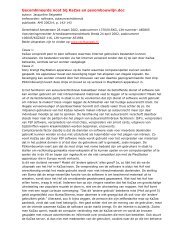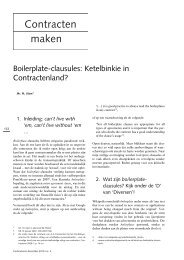- Page 1:
HET SCHEMERGEBIED VÓÓR FAILLISSEM
- Page 4 and 5:
Promotor: Prof. mr. R.D. Vriesendor
- Page 7:
Andermaal ontwaken, maar misschien
- Page 10 and 11:
IV. De verlengde Beklamel-norm en d
- Page 12 and 13:
VI.3.4 (Onverplichte) rechtshandeli
- Page 14 and 15:
VIII.3 Recapitulatie bezwaren tegen
- Page 16 and 17:
X.5 Keulen/BLG ....................
- Page 18 and 19:
XI.5 Nederlands recht, jurisprudent
- Page 21 and 22:
Lijst van afkortingen AA Ars Aequi
- Page 23 and 24:
I. Doel, richting en beperkingen va
- Page 25 and 26:
Doel, richting en beperkingen van h
- Page 27 and 28:
Doel, richting en beperkingen van h
- Page 29 and 30:
I.2.6 Conclusies Doel, richting en
- Page 31:
I.4 Ten slotte Doel, richting en be
- Page 34 and 35:
Hoofdstuk II kunnen markeren wannee
- Page 36 and 37:
Hoofdstuk II continuïteit. Aanspra
- Page 39 and 40:
III. De Beklamel-norm en de bij de
- Page 41 and 42:
De Beklamel-norm en de bij de faill
- Page 43 and 44:
De Beklamel-norm en de bij de faill
- Page 45 and 46:
De Beklamel-norm en de bij de faill
- Page 47 and 48:
De Beklamel-norm en de bij de faill
- Page 49 and 50:
De Beklamel-norm en de bij de faill
- Page 51 and 52:
De Beklamel-norm en de bij de faill
- Page 53 and 54:
De Beklamel-norm en de bij de faill
- Page 55 and 56:
De Beklamel-norm en de bij de faill
- Page 57 and 58:
III.4.2 Aandeelhouders als betrokke
- Page 59 and 60:
De Beklamel-norm en de bij de faill
- Page 61 and 62:
De Beklamel-norm en de bij de faill
- Page 63 and 64:
De Beklamel-norm en de bij de faill
- Page 65:
De Beklamel-norm en de bij de faill
- Page 68 and 69:
Hoofdstuk IV Bij de ontwikkeling va
- Page 70 and 71:
Hoofdstuk IV aangeduid worden als h
- Page 72 and 73:
Hoofdstuk IV door crediteuren verst
- Page 74 and 75:
Hoofdstuk IV continuïteitsveronder
- Page 76 and 77:
Hoofdstuk IV Als de liquiditeit onv
- Page 78 and 79:
Hoofdstuk IV - hoeft zij geen reser
- Page 80 and 81:
Hoofdstuk IV en solvabiliteit na di
- Page 82 and 83:
Hoofdstuk IV financiers. Om te kunn
- Page 84 and 85:
Hoofdstuk IV financiers, omdat zo
- Page 86 and 87:
Hoofdstuk IV Aan het begrip solvabi
- Page 88 and 89:
Hoofdstuk IV gedaan die de liquidit
- Page 90 and 91:
Hoofdstuk IV 68 kls. Vullen we dat
- Page 92 and 93:
Hoofdstuk IV Is de vordering van de
- Page 94 and 95:
Hoofdstuk IV Nederlandse banken daa
- Page 96 and 97:
Hoofdstuk IV aanlopen. Zo’n tekor
- Page 98 and 99:
Hoofdstuk IV verstrekt worden dan h
- Page 100 and 101:
Hoofdstuk IV Het spreekt vanzelf da
- Page 102 and 103:
Hoofdstuk IV het nadelige effect va
- Page 104 and 105:
Hoofdstuk IV Literatuur en rechtspr
- Page 106 and 107:
Hoofdstuk IV zo zijn beperkingen zo
- Page 108 and 109:
Hoofdstuk IV definitie zijn verplic
- Page 110 and 111:
Hoofdstuk IV beschouwd. Ook vanuit
- Page 112 and 113:
Hoofdstuk IV beter begrip van de no
- Page 114 and 115:
Hoofdstuk IV niet zonder meer gerea
- Page 117 and 118:
V. De positie van crediteuren in de
- Page 119 and 120:
De positie van crediteuren in de fi
- Page 121 and 122:
De positie van crediteuren in de fi
- Page 123 and 124:
De positie van crediteuren in de fi
- Page 125 and 126:
De positie van crediteuren in de fi
- Page 127 and 128:
De positie van crediteuren in de fi
- Page 129 and 130:
De positie van crediteuren in de fi
- Page 131 and 132:
De positie van crediteuren in de fi
- Page 133 and 134:
De positie van crediteuren in de fi
- Page 135 and 136:
De positie van crediteuren in de fi
- Page 137 and 138:
De positie van crediteuren in de fi
- Page 139 and 140:
De positie van crediteuren in de fi
- Page 141 and 142:
De positie van crediteuren in de fi
- Page 143 and 144:
De positie van crediteuren in de fi
- Page 145 and 146:
De positie van crediteuren in de fi
- Page 147 and 148:
De positie van crediteuren in de fi
- Page 149 and 150:
VI. De ‘Pauliana-norm’ voor wed
- Page 151 and 152:
De ‘Pauliana-norm’ voor wederpa
- Page 153 and 154:
De ‘Pauliana-norm’ voor wederpa
- Page 155 and 156:
De ‘Pauliana-norm’ voor wederpa
- Page 157 and 158:
De ‘Pauliana-norm’ voor wederpa
- Page 159 and 160:
De ‘Pauliana-norm’ voor wederpa
- Page 161 and 162:
De ‘Pauliana-norm’ voor wederpa
- Page 163 and 164:
De ‘Pauliana-norm’ voor wederpa
- Page 165 and 166:
De ‘Pauliana-norm’ voor wederpa
- Page 167 and 168:
De ‘Pauliana-norm’ voor wederpa
- Page 169 and 170:
De ‘Pauliana-norm’ voor wederpa
- Page 171 and 172:
De ‘Pauliana-norm’ voor wederpa
- Page 173 and 174:
De ‘Pauliana-norm’ voor wederpa
- Page 175 and 176:
De ‘Pauliana-norm’ voor wederpa
- Page 177 and 178:
De ‘Pauliana-norm’ voor wederpa
- Page 179 and 180:
De ‘Pauliana-norm’ voor wederpa
- Page 181 and 182:
De ‘Pauliana-norm’ voor wederpa
- Page 183:
De ‘Pauliana-norm’ voor wederpa
- Page 186 and 187:
Hoofdstuk VII VII.1 Inleiding en pl
- Page 188 and 189:
Hoofdstuk VII VII.2 Concrete benade
- Page 190 and 191:
Hoofdstuk VII alle nieuwe en doorlo
- Page 192 and 193:
Hoofdstuk VII Verminderingen van ei
- Page 194 and 195:
Hoofdstuk VII brengen en ontvangen
- Page 196 and 197:
Hoofdstuk VII Boedelschulden hebben
- Page 198 and 199:
Hoofdstuk VII VII.4.2 Stadia en omv
- Page 200 and 201:
Hoofdstuk VII 3a. actief 100 eigen
- Page 202 and 203:
Hoofdstuk VII dat het nadeel door b
- Page 204 and 205:
Hoofdstuk VII geen sprake van nadee
- Page 206 and 207:
Hoofdstuk VII uitkomsten kan leiden
- Page 208 and 209:
Hoofdstuk VII in een ongerechtvaard
- Page 210 and 211:
Hoofdstuk VII Zou nu het faillissem
- Page 212 and 213:
Hoofdstuk VII Min of meer spiegelbe
- Page 214 and 215:
Hoofdstuk VII verhoudingen samenkom
- Page 216 and 217:
Hoofdstuk VII inderdaad een boedels
- Page 218 and 219:
Hoofdstuk VII insolventie ontstane
- Page 220 and 221:
Hoofdstuk VII een relatief effect,
- Page 222 and 223:
Hoofdstuk VII van reclame, waarbij
- Page 224 and 225:
Hoofdstuk VII van de in te stellen
- Page 226 and 227:
Hoofdstuk VII 49 F niet door indivi
- Page 228 and 229:
Hoofdstuk VII VII.7.6 De Bont/Banne
- Page 230 and 231:
Hoofdstuk VII belangen van schuldei
- Page 232 and 233:
Hoofdstuk VII vorderingen van indiv
- Page 234 and 235:
Hoofdstuk VII rekening met het door
- Page 236 and 237:
Hoofdstuk VII Uitkeringspercentage
- Page 238 and 239:
Hoofdstuk VII van de verliezen. 621
- Page 240 and 241:
Hoofdstuk VII door ALM geleden scha
- Page 242 and 243:
Hoofdstuk VII Specifiek toegesneden
- Page 244 and 245:
Hoofdstuk VII moment dat de - op zi
- Page 246 and 247:
Hoofdstuk VII componenten: de event
- Page 248 and 249:
Hoofdstuk VII Onder de Beklamel-nor
- Page 250 and 251:
Hoofdstuk VII rekenen verlies zal z
- Page 252 and 253:
Hoofdstuk VII terugbrengen die daar
- Page 254 and 255:
Hoofdstuk VII wetenschap van feitel
- Page 256 and 257:
Hoofdstuk VII brengen nog reddingsp
- Page 258 and 259:
Hoofdstuk VII 236 en betreft niet e
- Page 260 and 261:
Hoofdstuk VII specifieke aantasting
- Page 263 and 264:
VIII. Benadeling door vermindering
- Page 265 and 266:
Benadeling door vermindering van vo
- Page 267 and 268:
Benadeling door vermindering van vo
- Page 269 and 270:
Benadeling door vermindering van vo
- Page 271 and 272:
Benadeling door vermindering van vo
- Page 273 and 274:
Benadeling door vermindering van vo
- Page 275 and 276:
Benadeling door vermindering van vo
- Page 277 and 278:
Benadeling door vermindering van vo
- Page 279 and 280:
Benadeling door vermindering van vo
- Page 281 and 282:
Benadeling door vermindering van vo
- Page 283 and 284:
Benadeling door vermindering van vo
- Page 285 and 286:
Benadeling door vermindering van vo
- Page 287 and 288:
Benadeling door vermindering van vo
- Page 289 and 290:
Benadeling door vermindering van vo
- Page 291 and 292:
Benadeling door vermindering van vo
- Page 293 and 294:
Benadeling door vermindering van vo
- Page 295 and 296:
Benadeling door vermindering van vo
- Page 297 and 298:
Benadeling door vermindering van vo
- Page 299 and 300:
Benadeling door vermindering van vo
- Page 301 and 302:
Benadeling door vermindering van vo
- Page 303 and 304:
Benadeling door vermindering van vo
- Page 305 and 306:
Benadeling door vermindering van vo
- Page 307 and 308:
Benadeling door vermindering van vo
- Page 309:
Benadeling door vermindering van vo
- Page 312 and 313:
Hoofdstuk IX (c) als wederpartij bi
- Page 314 and 315:
Hoofdstuk IX In grote lijnen leidt
- Page 316 and 317:
Hoofdstuk IX (2:384 lid 3 BW, RAC 5
- Page 318 and 319:
Hoofdstuk IX waarschuwing is begrij
- Page 320 and 321:
Hoofdstuk IX In Nimox/Van den End q
- Page 322 and 323:
Hoofdstuk IX worden. De Hoge Raad b
- Page 324 and 325:
Hoofdstuk IX IX.1.2.4 Ontbrekend in
- Page 326 and 327:
Hoofdstuk IX solvabiliteit aan te v
- Page 328 and 329:
Hoofdstuk IX gesteld door minimumei
- Page 330 and 331:
Hoofdstuk IX gestelde vraag. Voorra
- Page 332 and 333:
Hoofdstuk IX verhaal wordt gerealis
- Page 334 and 335:
Hoofdstuk IX (f) indien een bank me
- Page 336 and 337:
Hoofdstuk IX Dat neemt niet weg dat
- Page 338 and 339:
Hoofdstuk IX werkgelegenheid en con
- Page 340 and 341:
Hoofdstuk IX aandeelhouders, het ni
- Page 342 and 343:
Hoofdstuk IX beperkt omdat de kredi
- Page 344 and 345:
Hoofdstuk IX voldaan wordt aan de v
- Page 346 and 347:
Hoofdstuk IX het krediet op te zegg
- Page 348 and 349:
Hoofdstuk IX 4a. voorraad 400 eigen
- Page 350 and 351:
Hoofdstuk IX niet juist. Bij de vra
- Page 352 and 353:
Hoofdstuk IX De bank wint de zekerh
- Page 354 and 355:
Hoofdstuk IX door middel van zekerh
- Page 356 and 357:
Hoofdstuk IX waarom contractueel te
- Page 358 and 359:
Hoofdstuk IX Meer algemeen geldt da
- Page 360 and 361:
Hoofdstuk IX (v) een deel van de ba
- Page 362 and 363:
Hoofdstuk IX bouwnijverheid; 15% vo
- Page 365 and 366:
X. Wenselijk recht toegepast op cas
- Page 367 and 368:
Wenselijk recht toegepast op casus
- Page 369 and 370:
Bespreking: X.2.1 Relevante vragen
- Page 371 and 372:
Wenselijk recht toegepast op casus
- Page 373 and 374:
Wenselijk recht toegepast op casus
- Page 375 and 376:
Wenselijk recht toegepast op casus
- Page 377 and 378:
Wenselijk recht toegepast op casus
- Page 379 and 380:
Wenselijk recht toegepast op casus
- Page 381 and 382:
Wenselijk recht toegepast op casus
- Page 383 and 384:
Wenselijk recht toegepast op casus
- Page 385 and 386:
Wenselijk recht toegepast op casus
- Page 387 and 388:
Wenselijk recht toegepast op casus
- Page 389 and 390:
Wenselijk recht toegepast op casus
- Page 391 and 392:
Wenselijk recht toegepast op casus
- Page 393 and 394:
Wenselijk recht toegepast op casus
- Page 395 and 396:
X.4.2.3 Feitelijke insolventie (Bek
- Page 397 and 398:
Wenselijk recht toegepast op casus
- Page 399 and 400:
Wenselijk recht toegepast op casus
- Page 401 and 402:
Wenselijk recht toegepast op casus
- Page 403 and 404:
X.5.3 Eindoordeel naar wenselijk re
- Page 405 and 406:
Wenselijk recht toegepast op casus
- Page 407 and 408:
Wenselijk recht toegepast op casus
- Page 409 and 410:
Wenselijk recht toegepast op casus
- Page 411 and 412:
Wenselijk recht toegepast op casus
- Page 413 and 414:
Wenselijk recht toegepast op casus
- Page 415 and 416:
Wenselijk recht toegepast op casus
- Page 417 and 418:
X.9 Nimox/Van den End q.q. (HR 8-11
- Page 419 and 420:
Wenselijk recht toegepast op casus
- Page 421 and 422:
Wenselijk recht toegepast op casus
- Page 423 and 424:
Wenselijk recht toegepast op casus
- Page 425 and 426:
Wenselijk recht toegepast op casus
- Page 427 and 428:
Wenselijk recht toegepast op casus
- Page 429 and 430:
Wenselijk recht toegepast op casus
- Page 431 and 432:
Wenselijk recht toegepast op casus
- Page 433 and 434:
Wenselijk recht toegepast op casus
- Page 435 and 436:
X.11.3 Eindoordeel naar wenselijk r
- Page 437 and 438:
Wenselijk recht toegepast op casus
- Page 439 and 440:
Wenselijk recht toegepast op casus
- Page 441 and 442:
Wenselijk recht toegepast op casus
- Page 443 and 444:
Wenselijk recht toegepast op casus
- Page 445 and 446:
X.13.2 Relevante feiten en financi
- Page 447 and 448:
Wenselijk recht toegepast op casus
- Page 449 and 450:
Wenselijk recht toegepast op casus
- Page 451 and 452:
Wenselijk recht toegepast op casus
- Page 453 and 454:
Wenselijk recht toegepast op casus
- Page 455 and 456:
Wenselijk recht toegepast op casus
- Page 457 and 458:
Wenselijk recht toegepast op casus
- Page 459 and 460:
Wenselijk recht toegepast op casus
- Page 461 and 462:
Wenselijk recht toegepast op casus
- Page 463 and 464:
Wenselijk recht toegepast op casus
- Page 465 and 466:
Wenselijk recht toegepast op casus
- Page 467 and 468:
Wenselijk recht toegepast op casus
- Page 469 and 470:
Wenselijk recht toegepast op casus
- Page 471 and 472:
Wenselijk recht toegepast op casus
- Page 473 and 474:
Wenselijk recht toegepast op casus
- Page 475 and 476:
Wenselijk recht toegepast op casus
- Page 477 and 478:
Wenselijk recht toegepast op casus
- Page 479 and 480:
Wenselijk recht toegepast op casus
- Page 481 and 482:
Wenselijk recht toegepast op casus
- Page 483 and 484:
X.20.4 Evaluatie overwegingen Hoge
- Page 485 and 486:
Wenselijk recht toegepast op casus
- Page 487 and 488:
Wenselijk recht toegepast op casus
- Page 489:
Wenselijk recht toegepast op casus
- Page 492 and 493:
Hoofdstuk XI Er is geen nieuw empir
- Page 494 and 495:
Hoofdstuk XI Ook bij de kwantitatie
- Page 496 and 497:
Hoofdstuk XI ‘in het verkeer geld
- Page 498 and 499: Hoofdstuk XI Dit onderzoek heeft ni
- Page 500 and 501: Hoofdstuk XI verhoudingen tussen be
- Page 502 and 503: Hoofdstuk XII XII.1.2 Algemene conc
- Page 504 and 505: Hoofdstuk XII 482 bestuurders die d
- Page 506 and 507: Hoofdstuk XII 12. Ten behoeve van z
- Page 508 and 509: Hoofdstuk XII 486 aan de uitholling
- Page 510 and 511: Hoofdstuk XII 488 concrete solvabil
- Page 512 and 513: Hoofdstuk XII 490 Onderbouwing: VII
- Page 514 and 515: Hoofdstuk XII 492 gehouden met de b
- Page 516 and 517: Hoofdstuk XII 43. Bij de vraag of v
- Page 518 and 519: Hoofdstuk XII 496 Regres/hoofdelijk
- Page 520 and 521: Hoofdstuk XII 57. Financiering en o
- Page 522 and 523: Hoofdstuk XII 500 zich nog niet vol
- Page 524 and 525: Hoofdstuk XII 67. Verminderingen ei
- Page 526 and 527: Hoofdstuk XII 73. De vordering van
- Page 528 and 529: Hoofdstuk XII 506 verplichting tot
- Page 530 and 531: Hoofdstuk XII worden als de redding
- Page 533 and 534: XIII. Samenvatting in vogelvlucht I
- Page 535 and 536: Samenvatting in vogelvlucht De (ver
- Page 537 and 538: Samenvatting in vogelvlucht bevorde
- Page 539 and 540: Samenvatting in vogelvlucht mogelij
- Page 541 and 542: Samenvatting in vogelvlucht diverse
- Page 543 and 544: Samenvatting in vogelvlucht aan de
- Page 545 and 546: Samenvatting in vogelvlucht complic
- Page 547: XIV. Summary The following summaris
- Page 551 and 552: Summary - or as economists call it:
- Page 553 and 554: Jurisprudentie (op naam) Naam Vindp
- Page 555 and 556: Jurisprudentie Van der Feltz q.q./H
- Page 557 and 558: Jurisprudentie Mulder q.q./CLBN HR
- Page 559 and 560: Literatuur Adriaanse en Kuijl 2005
- Page 561 and 562: Literatuur Financiers studies, 1997
- Page 563 and 564: Literatuur Van Eeghen 2002 L.J. van
- Page 565 and 566: Literatuur Hicks 1939 J.R. Hicks, V
- Page 567 and 568: Literatuur 47 Fw" van prof.mr. J.B.
- Page 569 and 570: Literatuur Mian en Smith 1994 S.L.
- Page 571 and 572: Literatuur Preve 2003 L.A. Preve, 2
- Page 573 and 574: Literatuur Smith 1987 J.K. Smith,
- Page 575 and 576: Literatuur een pleidooi voor afscha





